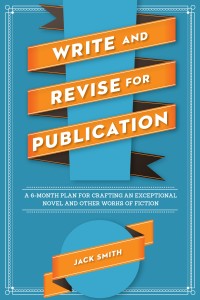Guest Post by Jack Smith
Fiction depends on tension. Tension—a felt response to conflict—must be heightened as well as diminished in a literary work. Where this is accomplished depends on the nature of the plot and the character arc. While tension is created by practically every story element, pacing is largely a result of style and narrative technique. The pacing of a work affects the tension but also creates mood and tone. In every fictional work you write, you must decide on both tension and pacing. While much of this may be a matter of intuition and feel, you can also plan out matters of tension and pacing as you write and revise your work. This amounts to a six-stage process.
I. Decide on the nature of the tension in your story or novel. Basically there are three major types of fictional works according to tension.
A. The five-stage plot structure, where tension must be gradually (though not continuously) increased to the story’s crisis and climax, followed by falling action and denouement.
B. The epiphany story where tension gradually builds toward a final, rather sudden, clarifying vision, on the part of the protagonist.
C. The story where tension builds at times, is released, or partly released, but does not build toward a climax at the end—but rather closes with the protagonist’s psychological distillation of several bumps along the way, no one bump necessarily involving more tension than the others.
II. As you rework and rethink your story or novel, decide how and where you might increase the tension and decrease it.
A. Consider your protagonist. What is likely to produce tension in this character? What is likely to relieve it?
B. What will be the main events that carry out your character’s overall trajectory? How are these tension-producing events?
C. What events will produce a reduction of tension? How are these events needed to develop your character’s overall trajectory?
III. Now work/rework your manuscript to make sure scenes create tension where needed, or decrease tension where needed.
A. In scenes that increase tension, depend on action and dialogue that emphasize conflict—conflict central to advancing the plot.
B. In scenes meant to relieve tension, depend on action and dialogue that decrease conflict, suggesting temporary resolution, compromises reached, hope for the future, and the like—all such scenes advancing the plot.
IV. Now work/rework your story or novel manuscript to make sure that expository sections of character thought and reflection represent increases in tension and times when this tension subsides.
A. Characters naturally respond to the external tensions in their lives. In your protagonist’s various thoughts and reflections, build this tension by exploring it for its possible negative, and even dire, effects of various kinds.
B. In sections where the tension subsides, provide moments of character reflection where feelings of relief occur, or even feelings of hope, At other times, find ways to have your protagonist think about other things besides the central tensions in his/her life, the ones that are driving the plot.
V. Make sure the pacing—whether in scene or narrative prose—contributes to the desired tension. Be sure the mood and tone created by the pacing is right for your work.
A. When the prose is smooth, fluid, easy-flowing, there is little tension—or apparent tension, at least.
B. When the prose is rapid-paced, the tension tends to increase, suggesting a positive feeling (e.g. excitement) or a negative one (e.g. worry or fear).
C. Decide on the right pacing for your story or novel, going through it scene by scene, and prose section by prose section. Which pacing creates the desired tension? Reduces the tension, as needed? Which pacing creates the right mood and tone?
VI. The narrative technique also creates pacing, and it too affects mood and tone.
A. If a story or novel is fragmented, with short, clipped sections, or white spaces that cause the reader to make “leaps,” this will suggest disorientation.
B. If a story or novel is traditionally narrated, with narrative bridges between sections, this may suggest a measure of coherence in the protagonist’s world (though such coherence can certainly be called into question by events and character reflection).
C. Decide on the right narrative technique for your work. Does it help create the right pacing—contributing to the desired tensions in the work? Does it create the right mood and tone?
Every literary work, short story or novel, must include tension—a felt response to conflict. A work without tension is almost unthinkable if it’s about life at all. But tension itself isn’t enough. You must handle the tension so that it builds, releases, builds, and also contributes to the advancement of the plot and overall character arc. You must also handle the pacing well, choosing the pacing that will contribute to the tensions in the work and help create the right mood and tone. Finally, you must choose the right narrative technique.
Jack Smith is author of the novel Hog to Hog, which won the George Garrett Fiction Prize (Texas Review Press. 2008), and is also the author of Write and Revise for Publication: A 6-Month Plan for Crafting an Exceptional Novel and Other Works of Fiction, published earlier this year by Writer’s Digest. His novel ICON was published in June 2014 by Serving House Book
Prize (Texas Review Press. 2008), and is also the author of Write and Revise for Publication: A 6-Month Plan for Crafting an Exceptional Novel and Other Works of Fiction, published earlier this year by Writer’s Digest. His novel ICON was published in June 2014 by Serving House Book
![]() Over the years, Smith’s short stories have appeared in North American Review, Night Train, Texas Review, and Southern Review, to name a few. He has also written some 20 articles for Novel & Short Story Writer’s Market, as well as a dozen or so pieces for The Writer.He has published reviews in numerous literary journals, including Ploughshares, Georgia Review, Missouri Review, Prairie Schooner, American Review, Mid-American Review, and the Iowa Review.
Over the years, Smith’s short stories have appeared in North American Review, Night Train, Texas Review, and Southern Review, to name a few. He has also written some 20 articles for Novel & Short Story Writer’s Market, as well as a dozen or so pieces for The Writer.He has published reviews in numerous literary journals, including Ploughshares, Georgia Review, Missouri Review, Prairie Schooner, American Review, Mid-American Review, and the Iowa Review.
What; tension isn’t created by a series of gasps, raised eyebrows, and lightening changes of mood?
I like that tension does not have to be built constantly; that it can trickle in as needed to further the plot, both character and overall story plot. When I read a story that ups the stakes with every chapter, not every scene, I am drawn to see what happens next. I like the anticipation of intrigue, and the consequences. Thanks for an insightful post Jack. It has been nice to meet you. I look forward to browsing your sites and getting to know you better.
Hello Elizabeth. Hope you have a good weekend.
Elizabeth – Thanks for hosting Jack.
Jack – Thanks for these ideas. One of the main reasons people stop reading a book is that there isn’t enough to keep their interest. Pacing the story appropriately and adding tension is a good antidote to that.
Tension is so important and he outlined everything one needs to consider. Awesome.
Tension is key – very useful, thanks Jack, for the pointers where to increase it and – equally important – where to decrease it, in order to prepare for the next “wave” of tension: the lower the decrease as the main character feels all is resolved, the greater the impact when everything goes wrong! Thanks for reminding us that the two go together, the ups and downs!
Thanks for the great tips. It’s tough for me to see this on my own when I’m a couple of drafts in. Beta readers really help me spot pacing issues that I’ve missed.
Thanks, everyone! I really appreciate your comments. I think it is difficult to judge just where to increase as well as increase tension in a given novel. i know I’m facing the problem right now in a historical novel I’ve been working on!